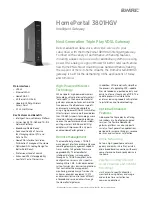
2.2 Fast-Track: Packet Data Call Setup
1. Create a 19,200 Generic Modem and configure it for 115,200, 8 bits, no parity, 1 stop bit.
Attach the modem to an active COM port on the PC, i.e. COM1.
2. Configure the selected COM port to a maximum speed of 115,200 in the Hardware
device manager.
3. Attach the antenna and power to the CDM-819 modem.
4. Connect it to the COM port with a 9 pin RS-232 straight through serial cable.
5.
If the modem has not been activated, activate the modem. See Section 2.3 and the
Appendix for information specific to your carrier.
6.
Use HyperTerminal on the COM port to set the Carrier Detect (DCD) to follow its
connection state to the Cellular Network, set
AT&C1.
The yellow LED will turn on when
connected to the Carrier, and turn off when not connected. A value of
AT&C0
sets CD to
always be on, and a value of
AT&C2
sets CD to be always on, but to wink when there is
a change in the connection state.
7.
Ensure that DTR is set to return to modem to command state on an ON-to-OFF transition
of DTR with
AT&D2
A value of
AT&D0
ignores DTR, a value of
AT&D1
enters
online command state upon
an ON-to-OFF transition of DTR.
8. To confirm your settings, do an
AT&V
. This will print out about 7 lines of text with all the
register values.
9. Confirm and that you are registered on the cellular network.
AT+CSS?
A reply of
+CSS?
2,Z,99999
indicates that you are not registered. It may take up to 15 seconds or so after
power-up to register on the network. Once registered a typical response will be
+CSS?:
1,A,4152
where 1 is the band class, 1=800 MHz, 2=1900 MHz, A-F is the band (Z
indicates not registered on network), 4152 is the SID, i.e. the cell tower ID, (99999
indicates not registered on network).
10. Create a Dial-Up Networking (DUN) connection using the modem that you created with
the active COM port, i.e. COM1 in Network and Dial-up Connections. Configure it to
115,200 bps and set Security to Typical.
11. Start a DUN session by double clicking on the DUN icon that was created.
12. Set the username and password as defined in the
Appendix
for your carrier.
13. Enter the phone number as #777 with no area code and click on Dial.
14. The modem will dial out and attempt to connect.
15. If the configured baud rate for the modem, the COM port, the modem and the DUN do
not match, the DUN will not be able to talk to the modem properly and you will get a
hardware error message. Otherwise the DUN will contact the cellular network and
authenticate the user on the network.
16. Once connected you will be able to browse the Internet through the DUN session. To
confirm this, disable any other network connection you may have running.










































